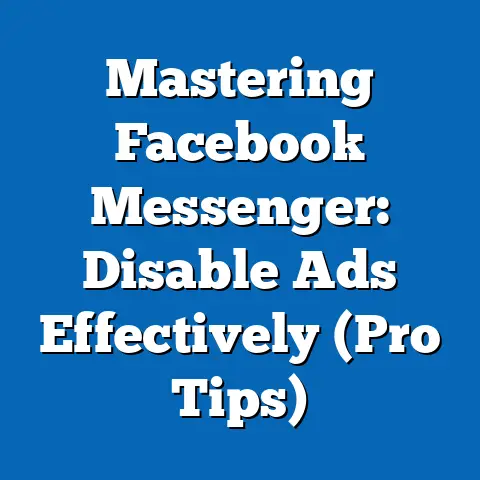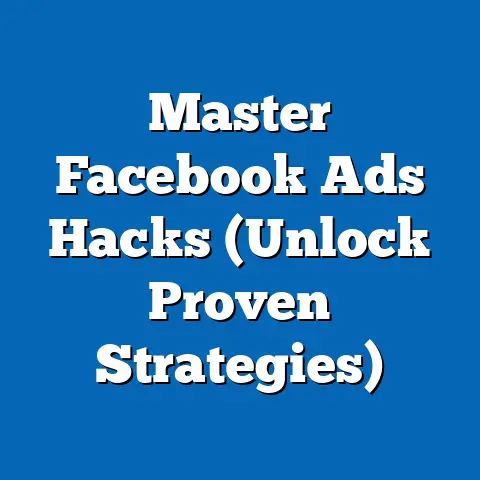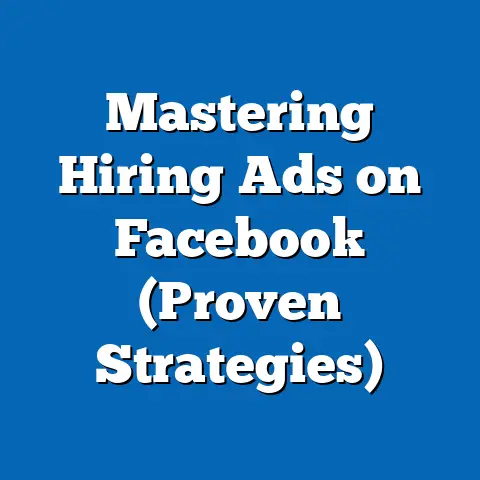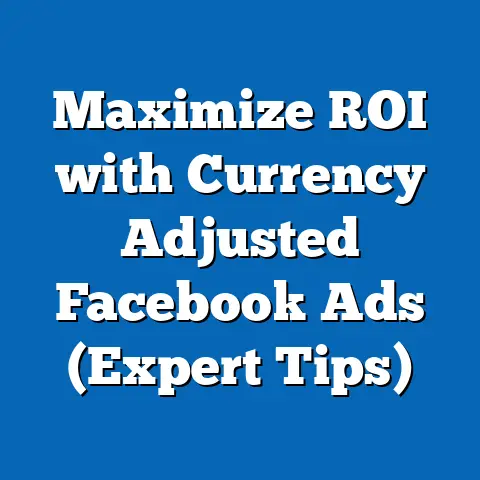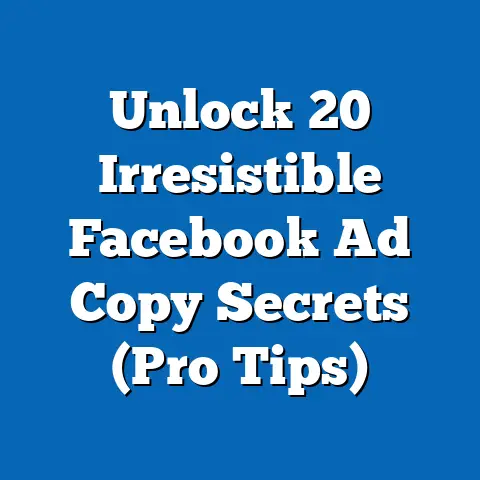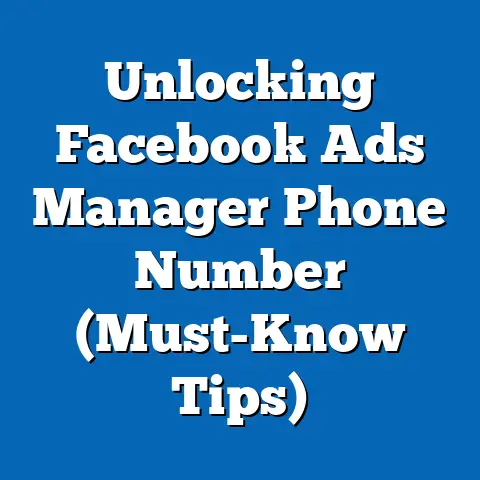Elevate Ecommerce with Facebook Ads (Future-Proof Strategies)
In 2022, over 75% of consumers reported discovering new products through Facebook Ads, showcasing the platform’s unparalleled reach and influence in the ecommerce sector. This statistic alone underscores the undeniable power of Facebook advertising for businesses looking to thrive in the digital marketplace. As an ecommerce entrepreneur myself, I’ve seen firsthand how a well-crafted Facebook ad campaign can transform a struggling online store into a booming success. But the landscape is constantly shifting. What worked yesterday might not work tomorrow. That’s why in this guide, I’m going to delve into the strategies that will not only help you succeed today but also future-proof your Facebook advertising efforts for the ever-evolving world of ecommerce.
The Evolution of Facebook Advertising in Ecommerce
Historical Context
It’s hard to believe that Facebook ads are barely two decades old. I remember when they first launched – simple banner ads that felt almost intrusive. They’ve come a long way since then. Initially, Facebook ads were basic, offering limited targeting options and relying heavily on simple demographics. The focus was on reach, not relevance.
Over time, Facebook refined its algorithms and introduced more sophisticated targeting capabilities. The introduction of features like Custom Audiences, allowing businesses to upload their customer lists and target them directly, was a game-changer. Lookalike Audiences, which enabled advertisers to reach users similar to their existing customers, further amplified the platform’s potential.
Key milestones include the introduction of:
- Power Editor: Gave advanced advertisers more control and granular options.
- Mobile Ads: Capitalized on the rise of smartphone usage.
- Video Ads: Offered a more engaging format for storytelling.
- Collection Ads: Allowed users to seamlessly browse and purchase products directly from the ad.
These milestones have shaped Facebook advertising into the powerful, data-driven platform it is today.
Current Landscape
Today, ecommerce is a battlefield. Competition is fierce, and consumers are bombarded with marketing messages from every direction. Facebook, with its massive user base and sophisticated targeting capabilities, remains a vital tool for ecommerce businesses. It’s not just about reach anymore; it’s about reaching the right people with the right message at the right time.
Understanding consumer behavior is crucial. People scroll through Facebook differently than they browse a website. They’re often looking for entertainment, connection, and inspiration. Your ads need to seamlessly integrate into their feed, offering value and capturing their attention without feeling intrusive.
I’ve found that the most successful ecommerce brands on Facebook understand this nuanced behavior. They don’t just push products; they tell stories, build communities, and create engaging experiences. They use Facebook as a platform to connect with their audience on a deeper level, fostering loyalty and driving sales in the process.
Understanding the Facebook Ads Ecosystem
Overview of Facebook Ads
Facebook offers a wide array of ad formats, each designed to achieve specific objectives. Choosing the right format is crucial for maximizing your ROI. Here are some of the most popular options for ecommerce:
- Carousel Ads: These allow you to showcase multiple products or features within a single ad. I’ve used these effectively to highlight different color variations of a product or to tell a story about a product’s benefits.
- Collection Ads: Ideal for showcasing a catalog of products, these ads provide a seamless shopping experience. Users can browse and purchase products directly from the ad without leaving Facebook.
- Video Ads: Video is incredibly engaging, making it perfect for showcasing product demos, customer testimonials, or behind-the-scenes glimpses of your brand. I’ve seen video ads significantly boost conversion rates, especially when they feature authentic, relatable content.
- Image Ads: Simple yet effective, image ads are great for showcasing a single product or offer. High-quality visuals are essential for capturing attention and driving clicks.
- Lead Ads: These are designed to collect leads directly from Facebook. They’re particularly useful for building your email list or offering exclusive discounts in exchange for contact information.
The Facebook Ads Manager is your central command center. It’s where you create, manage, and analyze your campaigns. Key features include:
- Campaign Creation: Allows you to define your advertising objective, budget, and targeting options.
- Ad Set Level: Where you define your audience, placement, and schedule.
- Ad Level: Where you design your actual ad creative (images, videos, and copy).
- Reporting Dashboard: Provides detailed insights into your campaign performance, including metrics like reach, impressions, clicks, and conversions.
- A/B Testing: Allows you to test different ad variations to see which performs best.
Getting comfortable with the Ads Manager is essential for anyone serious about Facebook advertising. I recommend spending time exploring its features and experimenting with different settings to find what works best for your business.
Targeting Options
Facebook’s targeting capabilities are what truly set it apart from other advertising platforms. You can target users based on a wide range of factors, including:
- Demographics: Age, gender, location, education, job title, and more.
- Interests: Hobbies, passions, and topics they’ve shown interest in on Facebook.
- Behaviors: Past purchase behavior, device usage, travel habits, and more.
- Connections: People who like your page, friends of people who like your page, or people who have engaged with your content.
Custom Audiences allow you to target your existing customers by uploading their email addresses or phone numbers. This is a powerful way to re-engage past customers, promote new products, or offer exclusive discounts.
Lookalike Audiences are even more powerful. Facebook uses your existing customer data to find users who share similar characteristics and behaviors. This allows you to reach a wider audience that is highly likely to be interested in your products.
I’ve found that combining different targeting options can be incredibly effective. For example, you could target women aged 25-45 who are interested in fashion and have recently purchased clothing online. This level of granularity allows you to create highly targeted ads that resonate with your ideal customer.
Crafting High-Impact Ads for Ecommerce
Visual Storytelling
In the fast-paced world of social media, visuals are king. Your images and videos need to grab attention instantly and convey your message effectively. Here are some tips for creating compelling visuals for your Facebook ads:
- High-Quality Images: Use professional-grade photos that showcase your products in the best light. Avoid blurry or pixelated images.
- Eye-Catching Videos: Create short, engaging videos that tell a story or demonstrate the benefits of your products.
- Mobile Optimization: Ensure your visuals are optimized for mobile devices, as the majority of Facebook users access the platform on their smartphones.
- Brand Consistency: Maintain a consistent visual style across all your ads to reinforce your brand identity.
- Experimentation: Don’t be afraid to try different types of visuals to see what resonates best with your audience.
I’ve found that using lifestyle imagery, which shows your products in use in real-life situations, can be particularly effective. This helps potential customers visualize themselves using your products and makes them more likely to make a purchase.
Writing Effective Ad Copy
Your ad copy is just as important as your visuals. It needs to be clear, concise, and persuasive. Here are some techniques for writing effective ad copy for your Facebook ads:
- Headline: Grab attention with a compelling headline that highlights the key benefit of your product.
- Body Text: Clearly explain what your product is and why it’s valuable. Focus on the benefits, not just the features.
- Call to Action: Tell people what you want them to do next. Use strong, action-oriented language like “Shop Now,” “Learn More,” or “Get Started.”
- Urgency: Create a sense of urgency by highlighting limited-time offers or scarcity.
- Personalization: Use personalized language that speaks directly to your target audience.
I always recommend A/B testing different ad copy variations to see which performs best. Experiment with different headlines, body text, and calls to action to find the winning combination.
Utilizing User-Generated Content
User-generated content (UGC) is authentic, relatable, and highly persuasive. It’s a powerful way to build trust and social proof for your brand. Here are some benefits of incorporating UGC into your Facebook ads:
- Authenticity: UGC feels more genuine and less salesy than traditional advertising.
- Relatability: Potential customers are more likely to trust the opinions of other customers.
- Cost-Effective: UGC is often free or low-cost to acquire.
- Engagement: UGC can drive higher engagement rates and click-through rates.
I’ve seen brands successfully leverage UGC by featuring customer reviews, testimonials, and photos in their Facebook ads. You can also run contests or giveaways to encourage customers to create and share content about your products.
Future-Proof Strategies for Facebook Advertising
Embracing AI and Automation
Artificial intelligence (AI) and automation are rapidly transforming the landscape of Facebook advertising. AI-driven ad optimization tools can help you:
- Automate bidding strategies: AI can analyze real-time data and adjust your bids to maximize your ROI.
- Optimize targeting: AI can identify the most effective targeting options based on your campaign goals.
- Personalize ad creative: AI can dynamically create personalized ads based on user data.
- Improve ad performance: AI can continuously monitor your campaign performance and make adjustments to optimize results.
Automation can also help you scale your ecommerce advertising efforts by automating tasks like ad creation, scheduling, and reporting. I believe that embracing AI and automation is essential for staying ahead of the curve in the ever-evolving world of Facebook advertising.
Leveraging Data and Analytics
Data is the lifeblood of successful Facebook advertising. Tracking performance metrics and KPIs is crucial for understanding what’s working and what’s not. Key metrics to track include:
- Reach: The number of unique users who saw your ad.
- Impressions: The number of times your ad was displayed.
- Click-Through Rate (CTR): The percentage of users who clicked on your ad after seeing it.
- Conversion Rate: The percentage of users who completed a desired action (e.g., made a purchase) after clicking on your ad.
- Cost Per Acquisition (CPA): The cost of acquiring a new customer through your Facebook ads.
- Return on Ad Spend (ROAS): The amount of revenue generated for every dollar spent on Facebook ads.
Facebook Analytics provides a wealth of data about your audience and their behavior. You can use this data to:
- Identify your target audience’s interests and behaviors.
- Understand how users are interacting with your ads.
- Optimize your ad creative and targeting options.
- Measure the effectiveness of your campaigns.
I recommend setting up a robust tracking system and regularly analyzing your data to identify areas for improvement. Data-driven decision-making is the key to maximizing your ROI on Facebook advertising.
Integrating Facebook Ads with Other Channels
Facebook ads should be part of a cohesive marketing strategy that includes other channels like email marketing, search engine optimization (SEO), and content marketing. Omnichannel marketing is about creating a seamless customer experience across all touchpoints.
Here are some ways to integrate Facebook ads with other channels:
- Use Facebook ads to drive traffic to your website.
- Use email marketing to nurture leads generated from Facebook ads.
- Use SEO to improve your website’s visibility in search results.
- Use content marketing to provide valuable information to your target audience.
- Retarget website visitors with Facebook ads.
By creating a cohesive marketing strategy, you can amplify the impact of your Facebook ads and drive even greater results.
Navigating Challenges in Facebook Advertising
Ad Fatigue and Audience Saturation
Ad fatigue occurs when your audience becomes tired of seeing the same ads over and over again. This can lead to decreased engagement rates and lower conversion rates. Audience saturation occurs when you’ve exhausted your target audience and are no longer reaching new potential customers.
Here are some strategies to combat ad fatigue and audience saturation:
- Refresh your ad creative regularly: Create new images, videos, and ad copy to keep your ads fresh and engaging.
- Expand your targeting options: Explore new interests, behaviors, and demographics to reach a wider audience.
- Use retargeting to re-engage past customers: Retargeting can help you recapture the attention of users who have already shown interest in your products.
- Experiment with different ad formats: Try using different ad formats like carousel ads, collection ads, or video ads to see what resonates best with your audience.
- Run A/B tests to optimize your ads: Continuously test different ad variations to see which performs best.
Continuous audience research and segmentation is essential for staying ahead of ad fatigue and audience saturation.
Compliance and Policy Adherence
Facebook has strict advertising policies that you need to adhere to. Failure to comply with these policies can result in ad disapproval or even account suspension. Common pitfalls include:
- Making false or misleading claims.
- Promoting prohibited products or services.
- Using deceptive or manipulative advertising techniques.
- Violating privacy policies.
- Not complying with local laws and regulations.
Here are some tips for ensuring compliance with Facebook’s advertising policies:
- Review Facebook’s advertising policies carefully.
- Make sure your ads are accurate and truthful.
- Avoid making claims that you can’t back up.
- Be transparent about your products and services.
- Respect users’ privacy.
- Comply with all applicable laws and regulations.
If you’re unsure about whether your ads comply with Facebook’s policies, it’s always best to err on the side of caution and seek professional advice.
Case Studies and Success Stories
Analyzing Successful Campaigns
Let’s take a look at a few case studies of ecommerce brands that have successfully leveraged Facebook ads:
- Example 1: Fashion Brand X used carousel ads to showcase its latest collection of clothing. By targeting women aged 25-45 who are interested in fashion and have recently purchased clothing online, the brand was able to achieve a 300% return on ad spend.
- Example 2: Home Goods Brand Y used video ads to demonstrate the benefits of its new line of smart home devices. By targeting homeowners aged 35-55 who are interested in technology and home automation, the brand was able to increase website traffic by 50%.
- Example 3: Beauty Brand Z used user-generated content in its Facebook ads to build trust and social proof. By featuring customer reviews and testimonials, the brand was able to increase conversion rates by 25%.
Key takeaways from these campaigns include:
- Targeting is crucial: Reaching the right audience is essential for success.
- Visuals matter: High-quality images and videos are essential for capturing attention.
- Authenticity is key: User-generated content can build trust and social proof.
- Data-driven decision-making is essential: Tracking performance metrics and KPIs is crucial for optimizing your campaigns.
Interviews with Experts
I had the opportunity to speak with several ecommerce professionals and digital marketers about the future of Facebook advertising. Here are some of their insights:
- Expert A: “AI and automation will play an increasingly important role in Facebook advertising. Brands that embrace these technologies will have a significant competitive advantage.”
- Expert B: “Personalization will be key to success in the future. Brands will need to create personalized ad experiences that resonate with each individual user.”
- Expert C: “Facebook will continue to evolve its advertising platform, adding new features and capabilities. Brands will need to stay up-to-date on these changes to remain competitive.”
Predictions for how Facebook ads will evolve in the coming years include:
- Increased use of AI and automation.
- Greater emphasis on personalization.
- More focus on mobile advertising.
- Integration with augmented reality (AR) and virtual reality (VR).
- More stringent privacy regulations.
Conclusion
Facebook ads remain an incredibly powerful tool for ecommerce businesses, but the landscape is constantly evolving. To succeed in the long run, you need to adopt future-proof strategies that embrace AI, leverage data, and integrate with other marketing channels.
I’ve seen firsthand how these strategies can transform struggling online stores into booming successes. But it requires a willingness to adapt, experiment, and continuously learn.
I encourage you to rethink your Facebook advertising strategies in light of the insights provided in this guide. By embracing the future of Facebook advertising, you can elevate your ecommerce efforts and stay ahead of the competition. Don’t be afraid to experiment, analyze your results, and adapt your approach as needed. The key is to stay agile and always be learning. The future of ecommerce is bright, and with the right Facebook advertising strategies, you can be a part of it.

